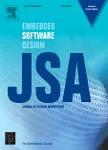版权所有:内蒙古大学图书馆 技术提供:维普资讯• 智图
内蒙古自治区呼和浩特市赛罕区大学西街235号 邮编: 010021

作者机构:Univ Carlos III Madrid Dept Telemat Engn Madrid Spain Univ Carlos III Madrid Distributed Real Time Syst Lab Madrid Spain Vanderbilt Univ Elect Engn & Comp Sci Nashville TN USA Vanderbilt Univ Smart Comp Lab Nashville TN USA Univ Politecn Valencia Comp Syst Valencia Spain
出 版 物:《JOURNAL OF SYSTEMS ARCHITECTURE》 (系统结构杂志)
年 卷 期:2018年第91卷
页 面:83-102页
核心收录:
学科分类:08[工学] 0835[工学-软件工程] 0812[工学-计算机科学与技术(可授工学、理学学位)]
主 题:Social dispersed computing IoT Fog Computing Cloud Computing Dispersed Computing Social Computing Edge Computing Distributed computing Cyber physical systems Real time Middleware Virtualization Containers Microservices Distributed transactions Blockchain Multi agent systems Distributed coordination Complex event processing Networking
摘 要:If last decade viewed computational services as a utility then surely this decade has transformed computation into a commodity. Computation is now progressively integrated into the physical networks in a seamless way that enables cyber-physical systems (CPS) and the Internet of Things (IoT) meet their latency requirements. Similar to the concept of platform as a service or software as a service, both cloudlets and fog computing have found their own use cases. Edge devices (that we call end or user devices for disambiguation) play the role of personal computers, dedicated to a user and to a set of correlated applications. In this new scenario, the boundaries between the network node, the sensor, and the actuator are blurring, driven primarily by the computation power of IoT nodes like single board computers and the smartphones. The bigger data generated in this type of networks needs clever, scalable, and possibly decentralized computing solutions that can scale independently as required. Any node can be seen as part of a graph, with the capacity to serve as a computing or network router node, or both. Complex applications can possibly be distributed over this graph or network of nodes to improve the overall performance like the amount of data processed over time. In this paper, we identify this new computing paradigm that we call Social Dispersed Computing, analyzing key themes in it that includes a new outlook on its relation to agent based applications. We architect this new paradigm by providing supportive application examples that include next generation electrical energy distribution networks, next generation mobility services for transportation, and applications for distributed analysis and identification of non-recurring traffic congestion in cities. The paper analyzes the existing computing paradigms (e.g., cloud, fog, edge, mobile edge, social, etc.), solving the ambiguity of their definitions;and analyzes and discusses the relevant foundational softwar